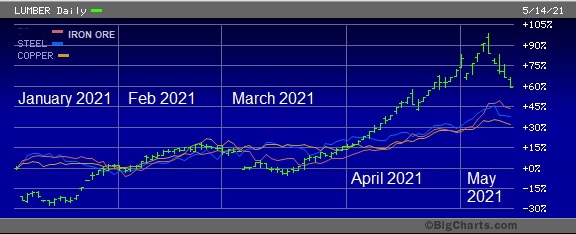By Pam Martens and Russ Martens: May 17, 2021 ~
During the current month of May, 2021, the following commodities have all set record high prices: lumber, iron ore, steel and copper. The volatility in the price of lumber this month has looked not all that dissimilar to the crazy price swings in the shares of GameStop, which have been under investigation for months by the U.S. Senate Banking and House Financial Services Committees. Thus far, however, there have been no announced hearings into what is causing these wild moves in commodity prices.
From 2016 through 2019, lumber prices traded between $300 and $600 per 1,000 board feet. During just this month, however, lumber has spiked to as high as $1,733.50. It closed on Friday at $1,390.
These skyrocketing prices in commodities are more than a little peculiar. The federal government believes that the economy of the U.S. is at such grave risk that Congress needed to infuse $1.9 trillion into the economy in a stimulus bill passed just two months ago.
Just a year ago, GDP in the U.S. for the second quarter had plunged by 32.9 percent, a worse quarterly record than even during the Great Depression. The grave worry then was deflation.
All of these commodities that have been setting historic record prices have one thing in common: they all trade on futures exchanges owned by the CME Group.
On April 11, 2014, three traders, William Charles Braman, Mark Mendelson and John Simms brought a lawsuit in the U.S. District Court for the Northern District of Illinois alleging that the CME Group was allowing “clandestine” contracts between the futures exchanges and high frequency traders and that potentially as much as 50 percent of the trades on the exchange are “wash trades.” Wash trades occur when the same beneficial owner is both the buyer and the seller. Wash trades, also known as wash sales, can falsely suggest volume and price movement.
CME Group is a publicly-traded stock and the traders in the lawsuit alleged that its motive for this conspiratorial conduct was as follows:
“The Exchange Defendants profit from the occurrence of wash trades and have a vested interest in not having more robust safeguards against them because they contribute significantly to the Exchange Defendants’ volume numbers and revenue. Were the volume of wash trades excluded from the Exchange Defendants’ volume and revenue numbers, the radically reduced volume numbers would exert adverse pressure on the CME Group’s stock price, not to mention the revenue to members of CME Group’s governance who have equity interests in participating HFTs [High Frequency Traders] in addition to stock ownership in the CME Group, Inc.”
The lawsuit also charged that the CME Group’s actions were effectively determining winners and losers, telling the court the following:
“Unlike the stock markets, commodity futures and option trading are ‘zero sum games.’ That is, the market actually has an offsetting loss for every gain in each commodity futures contract. The CME Group sold the foregoing products and exercised its monopoly power so as to enable the HFTs to achieve gains. For example, HFT firm Virtu Financial, Inc. disclosed in its SEC Form S-1 filed March 10, 2014 that it had experienced only one losing trading day out of the last 1238 trading days. In the zero sum game of commodity futures trading, the Class unnecessarily lost as a result of the guaranteed revenues.
“These two anticompetitive effects — guaranteed winners and guaranteed losers — represent a severe injury to competition. The competition in the commodity futures markets previously had been based on equal information. Here the effect of allowing preferred HFTs to see market information in advance of other market participants was to move prices in small increments in favor of these HFTs while at the same time to ensure that other market participants would lose accordingly. The final prices then become determined not by successfully predicting future market direction or by other skill or acumen, but by the rigged system created by Defendants’ discriminatory exercise of their monopoly power, agreements in unreasonable restraint of trade, and on-going misrepresentations and non-disclosures.
“The incredible performance of Virtu and other HFTs tracked an equally impressive increase in the Exchange Defendants’ revenues from greatly increased HFT transaction volume. In other words, the HFTs and Exchange Defendants knowingly profited from the losses of Plaintiffs and the Class.”
The CME Group hired the powerful, Washington-connected law firm Skadden, Arps, Slate, Meagher & Flom, LLP to represent it in court and the Judge, on December 3, 2015, granted CME’s request to dismiss the case on the basis that the plaintiffs had failed to state a claim. A careful reading of the Judge’s decision should raise a multitude of questions about just how fair-minded the Judge, John Robert Blakey, actually was.
The case was Braman et al v. The CME Group, Inc., et al. The Civil Docket for the case is #: 1:14-cv-02646.
For how the CME Group got permission from its federal regulator to trade bitcoin futures, see our recent article: The Smartest Guys in the Room Call Bitcoin “Rat Poison Squared,” “a Colossal Pump-and-Dump Scheme” and “a Big Criminal Scam” but Federal Regulators Look the Other Way.



